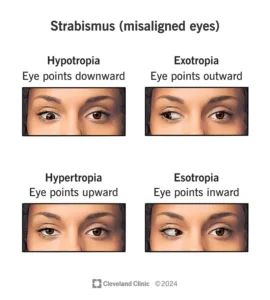Strabismus is an eye disorder that causes misalignment, where one or both eyes don’t look in the same direction at the same time. More commonly, the eyes can appear crossed or turned-in toward the nose, which is known as esotropia. Exotropia, less common, is where the eyes turn outward. They can also go up (hypertropia) or down (hypotropia). Three million cases are diagnosed each year in the United States, and it is usually (but not always) present at birth. According to the Mayo Clinic, almost one out of 20 kids has strabismus overall.
Causes
There are many and varied reasons strabismus can occur. Lack of muscle control is the most usual cause. Sometimes focusing issues, like straining to focus for farsightedness, can lead to the misalignment. Genetics can play a role if there’s a family history of the condition. Trauma, brain disorders such as stroke or tumors, or other types of nerve damage can contribute to developing strabismus. And sometimes environmental factors like shellfish poisoning or botulism can play a role.
Symptoms
The most obvious sign of strabismus is the crossing of the eyes. But people who experience the condition (i.e., babies or children) won’t necessarily be aware of this. It’ll be other people who are looking at them who will notice it. For a person with strabismus who has perhaps developed the condition after a stroke, for example, they may notice double vision issues or suddenly not being able to judge distances accurately. Poor depth perception can be a particular problem when driving or walking down stairs. Strabismus can lead to eyestrain, causing headaches and eye fatigue.
Treatment
If strabismus is present at birth or during childhood, it is critical to get your child treated by an eye doctor because if left uncorrected, the condition can have far-reaching effects that could include loss of vision and stereoacuity and psychosocial development and gainful employment as adults.
Improvement of some types of strabismus can be achieved with corrective eyeglasses for refractive errors like nearsightedness, farsightedness, or astigmatism. In other cases, prism lenses can help to bend light, which shifts the image and can align the eyes. Vision therapy can help with muscle control, especially in exotropia cases. For some, patching one eye can help with forcing the weaker eye to work harder to match the stronger eye. Surgery may also be an option if none of the above helps with the misalignment.
It’s important to rule out and address other underlying conditions (like cataracts) with a comprehensive eye exam. And catching the condition early with children will go a long way toward preserving their vision.


